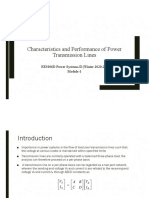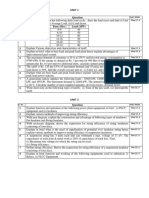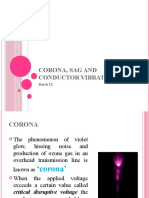Performance of Line (Power System)
Uploaded by
EE-053-Nirmal TuduPerformance of Line (Power System)
Uploaded by
EE-053-Nirmal TuduA Progress Report On
[Performance of Lines]
Submitted in partial fulfillment of the requirement for the degree.
OF
BACHELOR OF TECHNOLOGY
IN
ELECTRICAL ENGINEERING
BY
Nirmal Tudu
{Registration No.: - 213500101610016, University Roll No.: - 35001621053}
DR. JAYANTA KUMAR CHANDRA
(H.O.D OF EE, RKMGEC)
Subject: - Power System-I, Subject code: -PC-EE-502
Semester- 5th Sem, Year-3rd year
Department Of Electrical Engineering
Ramkrishna Mahato Government Engineering College
Joypur, Purulia, Pin – 723103, West Bengal
❖ Performance of Lines inTroDUcTion: -
❑ Definition: By performance of lines is meant the determination of
efficiency and regulation of lines.
The efficiency of lines is defined as,
% efficiency = (Power delivered at the receiving end / Power sent from
the sending end) × 100
% efficiency = (Power delivered at the receiving end / Power delivered
at the receiving end + losses) × 100
The end of the line where load is connected is called the receiving end
and where source of supply is connected is called the sending end.
The regulation of a line is defined as the change in the receiving end
voltage, expressed in per cent of full load voltage, from no load to full
load, keeping the sending end voltage and frequency constant.
Expressed mathematically,
𝑉𝑟 ′ −𝑉𝑟
% regulation = × 100
𝑉𝑟
where 𝑉𝑟 ′ is the receiving end voltage under no load condition and 𝑉𝑟
the receiving end voltage under full load condition. It is to be noted
here that 𝑉𝑟 ′ and 𝑉𝑟 are the magnitudes of voltages.
❑ REPRESENTATION OF LINES: -
A transmission line is a set of conductors being run from one place to
another supported on transmission towers. Such lines, therefore, have
four distributed parameters, series resistance and inductance, and
shunt capacitance and conductance. It will be shown later on in this
chapter that the voltages and currents vary harmonically along the line
with respect to the distance of the point under consideration. This
observation is very important in representing the lines of different
lengths. It is to be noted that the electrical power is being transmitted
over the overhead lines at approximately the speed of light. In order
to get one full wave variation of voltage or current on the line the
length of the line for 50 Hz supply will be given by -
f.λ=v
where, f is frequency of supply, λ is the wavelength i.e., the length of
the line in this case and v the velocity of the wave i.e., the velocity of
light.
❑ SHORT TRANSMISSION LINE: -
A short transmission line is defined as a transmission line with an
effective length less than 80 km (50 miles), or with a voltage less than
69 kV. Unlike medium transmission lines and long transmission lines,
the line charging current is negligible, and hence the shunt capacitance
can be ignored.
For short length, the shunt capacitance of this type of line is neglected
and other parameters like electrical resistance and inductor of these
short lines are lumped, hence the equivalent circuit is represented as
given below. Let’s draw the vector diagram for this equivalent circuit,
taking receiving end current 𝐼𝑟 as reference. The sending end and
receiving end voltages make angle with that reference receiving end
current, of 𝜑𝑠 and 𝜑𝑠′ respectively.
As the shunt capacitance of the line is neglected, hence the sending
end current and the receiving end current is same, i.e.
𝐼𝑠 = 𝐼𝑟
We can see from the short
transmission line phasor diagram
above that Vs is approximately equal
to:
𝑉𝑟 + 𝐼𝑟 . 𝑅. 𝑐𝑜𝑠𝜑𝑟 + 𝐼𝑟 . 𝑋. 𝑠𝑖𝑛𝜑𝑟
That means, 𝑉𝑠 ≈ 𝑉𝑟 + 𝐼𝑟 . 𝑅. 𝑐𝑜𝑠𝜑𝑟 +
𝐼𝑟 . 𝑋. 𝑠𝑖𝑛𝜑𝑟
As it is assumed that: 𝜑𝑠 ≈ 𝜑𝑟
As there is no capacitance, during no-load condition the current
through the line is considered as zero, hence at no load condition,
receiving end voltage is the same as sending end voltage. As per
dentition of voltage regulation of power transmission line,
Here, Vr and Vx are the per unit resistance and reactance of the short
transmission line respectively.
❑ ABCD CONSTANTS OF A SHORT LINE: -
Hence two-port network of the transmission line can be represented as
2 by 2 matrix. Here the concept of ABCD parameters comes into play.
Voltage and currents of the network can be represented as:
Where, A, B, C and D are the different
constants of the transmission network.
If we put Ir = 0 at equation (1), we get,
Hence A is the voltage impressed at the sending end per volt at the
receiving end when receiving end is open. It is dimensionless. If we
put Vr = 0 at equation (1), we
get,
Hence B indicates the impedance of the transmission line when the
receiving terminals are short-
circuited. This parameter is referred
to as the transfer impedance.
C is the current in amperes into the sending end per volt on open
circuited receiving end. It has the dimension of
admittance.
D is the current in amperes into the sending end per
amp on the short-circuited receiving end. It is dimensionless. Now
from the equivalent circuit, it is found that,
Comparing these equations with equation 1 and 2 we get, A = 1, B =
Z, C = 0 and D = 1. As we know that the constant A, B, C, and D are
mathematically related to a passive network as:
AD − BC = 1Here, A = 1, B = Z, C = 0, and D = 1 ⇒ 1.1 −Z.0 =1 So
the values calculated are correct for a short transmission line.
❑ Medium Transmission Line: -
A medium transmission line is defined as a transmission line with an
effective length more than 80 km (50 miles) but less than 250 km (150
miles). Unlike a short transmission line, the line charging current of a
medium transmission line is appreciable and hence the shunt
capacitance must be considered (this is also the case for long
transmission lines). This shunt capacitance is captured within the
admittance (“Y”) of the ABCD circuit parameters.
The ABCD parameters of a medium length transmission line is
calculated using a lumped shunt admittance, along with the lumped
impedance in series to the circuit. These lumped parameters of a
medium length transmission line can be represented using three
different models, namely:
1. Nominal Π representation (nominal pi model)
2. Nominal T representation (nominal T model)
3. End Condenser Method
ABCD Parameters of Medium Transmission Line Nominal Π
Representation of a Medium Transmission Line In case of a nominal
Π representation (i.e. nominal pi model), the lumped series impedance
is placed at the middle of the circuit whereas the shunt admittances
are at the ends. As we can see from the diagram of the Π network
below, the total lumped shunt admittance is divided into 2 equal
halves, and each half with value Y ⁄ 2 is placed at both the sending and
the receiving end while the entire circuit impedance is between the
two.
The shape of the circuit so formed resembles that of a symbol Π, and
for this reason, it is known as the nominal Π representation of a
medium transmission line. It is mainly used for determining the
general circuit parameters and performing load flow analysis.
As we can see here, VS and VR is the supply and receiving end voltages
respectively, and Is is the current flowing through the supply end. IR is
the current flowing through the receiving end of the circuit. I 1 and I3
are the values of currents flowing through the admittances. And I 2 is
the current through the impedance Z.
❑ ABCD CONSTANTS OF A MEDIUM LINE: -
❑ LONG Transmission Line: -
A long transmission line is defined as a transmission line with an
effective length more than 250 km (150 miles). Unlike short
transmission lines and medium transmission lines, it is no longer
reasonable to assume that the line parameters are lumped. To
accurately model a long transmission line we must consider the exact
effect of the distributed parameters over the entire length of the line.
Although this makes the calculation of ABCD parameters of
transmission line more complex, it also allows us to derive expressions
for the voltage and current at any point along the line.
In a long transmission line the line constants are uniformly distributed
over the entire length of line. This is because the effective circuit length
is much higher than what it was for the former models (long and
medium line) and hence we can no longer make the following
approximations:
1. Ignoring the shunt admittance of the network, like in a small
transmission line model.
2.Considering the circuit impedance and admittance to be lumped
and concentrated at a point as was the case for the medium line
model.
A transmission line having a length more than 240 km is consider as
a long transmission line. In a long transmission line, parameters are
uniformly distributed along the whole length of the line. Rather, for
all practical reasons, we should consider the circuit impedance and
admittance being distributed over the entire circuit length as shown in
the figure below. The calculations of circuit parameters, for this
reason, are going to be slightly more rigorous as we will see here. For
accurate modelling to determine circuit parameters let us consider the
circuit of the long transmission line.
Here a line of length l > 250km is supplied with a sending end
voltage and current of VS and IS respectively, whereas the VR and IR
are the values of voltage and current obtained from the receiving
end. Lets us now consider an element of infinitely small length Δx at
a distance x from the receiving end as shown in the figure where.
V = value of voltage just before entering the element Δx.
I = value of current just before entering the element Δx.
V+ΔV = voltage leaving the element Δx.
I+ΔI = current leaving the element Δx.
ΔV = voltage drop across element Δx.
zΔx = series impedance of element Δx
yΔx = shunt admittance of element Δx
❑ ABCD CONSTANTS OF A long LINE: -
❑ REFERENCE: -
I. Electric Power transmission & Distribution, S.Sivanagaraju,
S.Satyanarayana,, Pearson Education.
II. A Textbook on Power system Engineering, Soni, Gupta,
Bhatnagar & Chakrabarti, Dhanpat Rai & Co.
You might also like
- Assignment #3 CH 7 Power System SecurityNo ratings yetAssignment #3 CH 7 Power System Security2 pages
- Medium Transmission Line: What Is It? (Plus ABCD Parameters) What Is Medium Transmission Line?No ratings yetMedium Transmission Line: What Is It? (Plus ABCD Parameters) What Is Medium Transmission Line?4 pages
- Hybrid Solar Inverter: Project Guide MR - Vishwaprakash BabuNo ratings yetHybrid Solar Inverter: Project Guide MR - Vishwaprakash Babu12 pages
- Residential Electrical Cut - Off Using A Network Base Embedded ControllerNo ratings yetResidential Electrical Cut - Off Using A Network Base Embedded Controller15 pages
- Power Management of Standalone Hybrid Energy Systems: A Proposed Research Presentation OnNo ratings yetPower Management of Standalone Hybrid Energy Systems: A Proposed Research Presentation On42 pages
- Eee Vii Electrical Power Utilization (10ee72) AssignmentNo ratings yetEee Vii Electrical Power Utilization (10ee72) Assignment8 pages
- BET Unit 5 - Power System & Electrical MachinesNo ratings yetBET Unit 5 - Power System & Electrical Machines40 pages
- Implementation of Single-Phase PQ Theory: Mehrdad Tarafdar Haque, and Toshifumi H eNo ratings yetImplementation of Single-Phase PQ Theory: Mehrdad Tarafdar Haque, and Toshifumi H e5 pages
- GATE 2019 EE Answer Key & Solutions PDFNo ratings yetGATE 2019 EE Answer Key & Solutions PDF28 pages
- Carleton University: Name: Signature: Student #No ratings yetCarleton University: Name: Signature: Student #7 pages
- Corona, Sag and Conductor Vibration: Batch IX100% (1)Corona, Sag and Conductor Vibration: Batch IX15 pages
- Module Information Module Title Electric Drives and Control Module Code MMD2511No ratings yetModule Information Module Title Electric Drives and Control Module Code MMD25114 pages
- Power System By: Roel B. Calano: Problem 1No ratings yetPower System By: Roel B. Calano: Problem 110 pages
- 1 Basic Principles: 1.1 Power in Single-Phase AC CircuitsNo ratings yet1 Basic Principles: 1.1 Power in Single-Phase AC Circuits9 pages
- Capítulo 1 Basic Concepts - em - InglêsNo ratings yetCapítulo 1 Basic Concepts - em - Inglês49 pages
- Electric Power Transmission and Distribution System Engineering 2 RBCNo ratings yetElectric Power Transmission and Distribution System Engineering 2 RBC17 pages
- Performance Evaluation of A Selected Pump and FanNo ratings yetPerformance Evaluation of A Selected Pump and Fan2 pages
- Soft Real Time Simulation of A DC Motor Considering Power LossesNo ratings yetSoft Real Time Simulation of A DC Motor Considering Power Losses20 pages
- CEC Value of DA: Distribution Automation Detailed Scenarios: XanthusNo ratings yetCEC Value of DA: Distribution Automation Detailed Scenarios: Xanthus19 pages
- G.K. Dubey, Fundamentals of Electrical Drives', Narosa Publishing House, 2nd Edition, 2008No ratings yetG.K. Dubey, Fundamentals of Electrical Drives', Narosa Publishing House, 2nd Edition, 20081 page
- Method of Symmetrical Coordinates Applied To The Solution of Polyphase Networks-6No ratings yetMethod of Symmetrical Coordinates Applied To The Solution of Polyphase Networks-6114 pages
- DEREGULATED POWER SYSTEM Solution KEE 078No ratings yetDEREGULATED POWER SYSTEM Solution KEE 07818 pages
- Microgrid Implementation Challenges and Key Technologies: Executive SummaryNo ratings yetMicrogrid Implementation Challenges and Key Technologies: Executive Summary6 pages
- Medium Transmission Line: What Is It? (Plus ABCD Parameters) What Is Medium Transmission Line?Medium Transmission Line: What Is It? (Plus ABCD Parameters) What Is Medium Transmission Line?
- Hybrid Solar Inverter: Project Guide MR - Vishwaprakash BabuHybrid Solar Inverter: Project Guide MR - Vishwaprakash Babu
- Residential Electrical Cut - Off Using A Network Base Embedded ControllerResidential Electrical Cut - Off Using A Network Base Embedded Controller
- Power Management of Standalone Hybrid Energy Systems: A Proposed Research Presentation OnPower Management of Standalone Hybrid Energy Systems: A Proposed Research Presentation On
- Eee Vii Electrical Power Utilization (10ee72) AssignmentEee Vii Electrical Power Utilization (10ee72) Assignment
- Implementation of Single-Phase PQ Theory: Mehrdad Tarafdar Haque, and Toshifumi H eImplementation of Single-Phase PQ Theory: Mehrdad Tarafdar Haque, and Toshifumi H e
- Module Information Module Title Electric Drives and Control Module Code MMD2511Module Information Module Title Electric Drives and Control Module Code MMD2511
- 1 Basic Principles: 1.1 Power in Single-Phase AC Circuits1 Basic Principles: 1.1 Power in Single-Phase AC Circuits
- Electric Power Transmission and Distribution System Engineering 2 RBCElectric Power Transmission and Distribution System Engineering 2 RBC
- Soft Real Time Simulation of A DC Motor Considering Power LossesSoft Real Time Simulation of A DC Motor Considering Power Losses
- CEC Value of DA: Distribution Automation Detailed Scenarios: XanthusCEC Value of DA: Distribution Automation Detailed Scenarios: Xanthus
- G.K. Dubey, Fundamentals of Electrical Drives', Narosa Publishing House, 2nd Edition, 2008G.K. Dubey, Fundamentals of Electrical Drives', Narosa Publishing House, 2nd Edition, 2008
- Method of Symmetrical Coordinates Applied To The Solution of Polyphase Networks-6Method of Symmetrical Coordinates Applied To The Solution of Polyphase Networks-6
- Microgrid Implementation Challenges and Key Technologies: Executive SummaryMicrogrid Implementation Challenges and Key Technologies: Executive Summary



























































